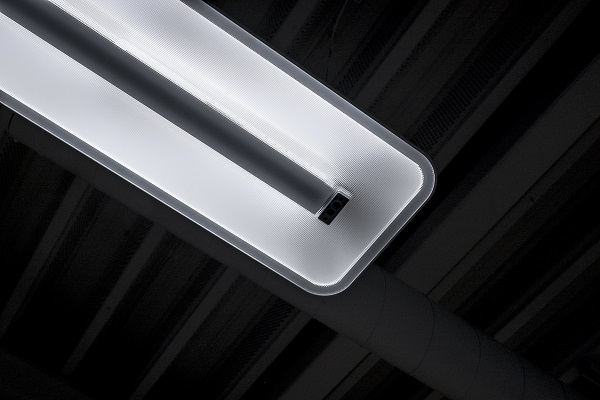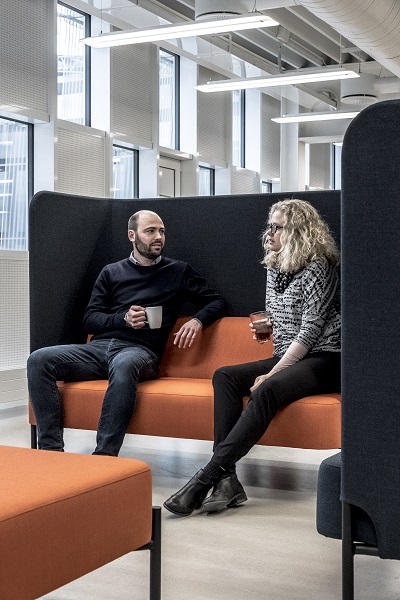Philips Lighting have installed the first Power-over-Ethernet (PoE) connected lighting system in the Nordics, using Cisco network technology. The Philips lighting system in the newly built smart office in Albertslund Municipality in Copenhagen, Denmark, gives its building managers unique insights into energy use and space utilization, while enabling office workers to personalize their office lighting using a smartphone app. The project is a key landmark in Copenhagen’s Lighting Metropolis initiative.
The smart office features a Philips PoE connected lighting system with occupancy sensors integrated with Philips SmartBalance and Philips PowerBalance luminaires. Approximately 400 LED light fixtures are connected to Cisco’s secure networking technology and powered by the small electric charge carried by the network’s Ethernet cables, which also route data acquired by the sensors to the building’s management system.
 |
|
(Image: Philips Lighting) |
Albertslund Municipality foresees the energy-efficient connected office lighting system as a paradigm shift in public digital management and service.
“The new connected lighting system provides us with an infrastructure fit for the digital age. The municipality expects that the results will be promising enough to broaden the use of such technology to other municipality buildings – with the initial focus on buildings used for administration, healthcare and learning. Environments where lighting can be adjusted by staff to meet their needs and have sensor-based functions are becoming increasingly important,” said Niels Carsten Bluhme, Director of City, Environment, Culture & Employment at Albertslund Municipality.
The smart office represents a milestone in the EU-funded ‘Lighting Metropolis’ initiative, which plans to make the whole of Greater Copenhagen a vibrant laboratory for connected lighting. The Albertslund Municipality smart office is one of the initiative’s initial projects and joins more than 25 other demonstration projects under development, from lighting for psychiatry to traffic lights and lighting for schools.
 |
|
(Image: Philips Lighting) |
Bright and connected
The connected lighting system uses Cisco PoE switches that transmit power and data over standard ethernet cables. Data acquired by the sensors in the lighting fixtures will provide new insights into the building's use and operations. Information, such as light levels, energy consumption and room occupancy, will help building managers to optimize energy use and management of the office space. The connected lighting system also gives office workers the ability to control the lighting and other building services with their smart phones. This supports the Municipality’s goal of creating an excellent working environment that increases employee satisfaction and productivity, ensuring that employees have the right light for any given task.
"We are looking at an exciting future where we will see smart buildings that provide valuable information on their use. Light typically accounts for about 40% of a building's electricity use.
Switching to Philips connected LED lighting can result in electricity savings of up to 80% as well as lower maintenance costs, gains in productivity and last, but not least, an optimized working environment," says Astrid Simonsen Joos, CEO of Philips Lighting for the Nordic Region. "We are pleased with our ground-breaking collaboration with Cisco, TDC and Albertslund Municipality on this project, which is the first of its kind in the Nordic region," she added.
 |
|
(Image: Philips Lighting) |
Digital partnerships for the future
This latest smart office implementation further underlines the capability of the global relationship between Philips Lighting and Cisco.
"Cisco has continuously been a leader in technology-driven innovation that helps us build a sustainable and intelligent future. The smart office environment we have built in collaboration with Albertslund Municipality, TDC and Philips Lighting is a world-class example. A converged solution of network technology, electricity, light and dynamic input from office users has given us the opportunity to create a more energy efficient, vibrant and adaptable environment that paves the way for the future," said Claus Holm, Regional Sales Manager, Cisco Northern Europe.
TDC Erhverv installed the system and other technologies, including Wi-Fi and video conferencing equipment, and led the project’s overall management.
"We are very pleased with this project that points to the future of offices. It is important for us to develop Denmark’s digital capabilities and a project like this illustrates how a digital future may be created in partnership with public and private parties, showing the way forward,” said Marina Lønning, CEO of TDC Erhverv.
The new smart office in Albertslund went into service in autumn 2017.














